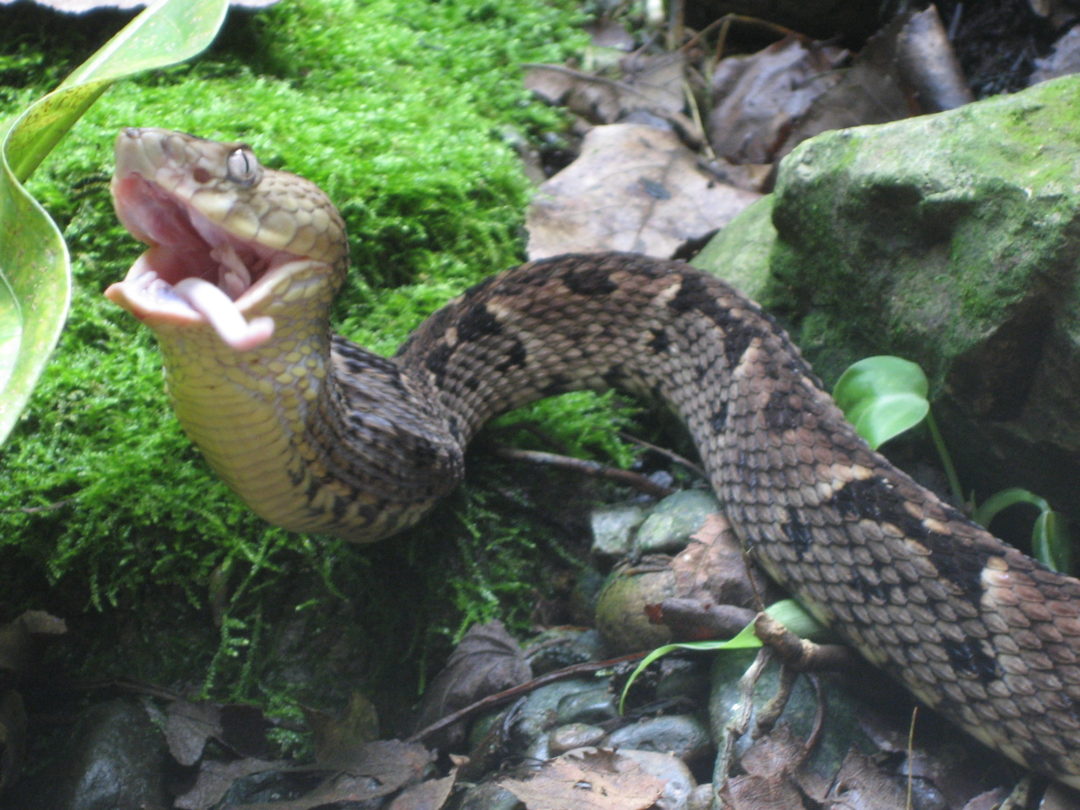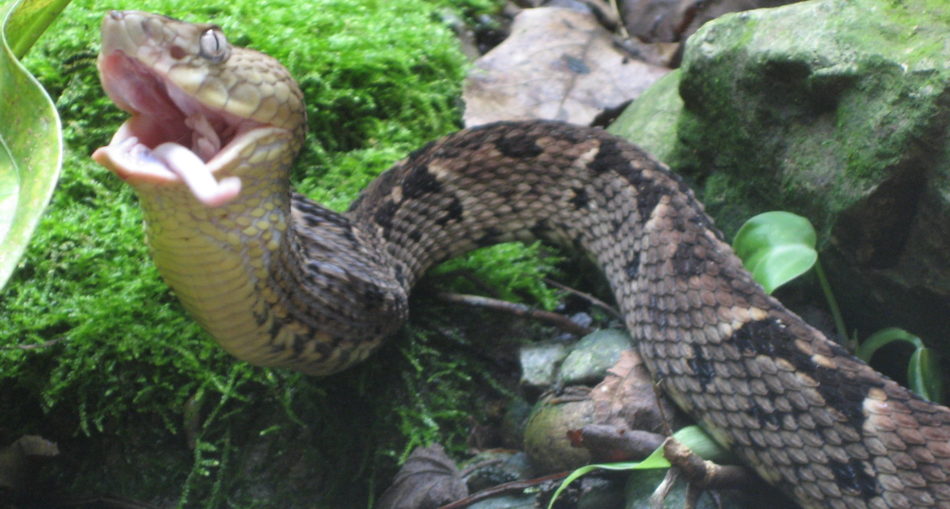The Morabana (Bothrops brazili) is a venomous pit viper species in Guyana. This snake is usually heavy-set and primarily found on land, though it can be found in water (passing through). It is a huge snake and can be as long as five to six feet, or even more. The females are usually larger than the males. This article will reveal further information about this fascinating snake.
The Morabana (Bothrops brazili) is a venomous pit viper species in Guyana. This snake is usually heavy-set and primarily found on land, though it can be found in water (passing through). It is a huge snake and can be as long as five to six feet, or even more. The females are usually larger than the males. This article will reveal further information about this fascinating snake.
Features Of The Morabana
- Pattern – The color pattern consists of a pinkish tan to pinkish or reddish gray ground color overlaid with a series of 9-19 dark ash gray dorsolateral blotches. These may alternate or oppose across the midline of the back, sometimes looking like triangular C’s or merging to form bands.
- Tail – The tail is the same color as the body, but may be mostly black.
- Belly – The belly is usually yellow or pinkish cream with mottling that is slightly darker in color.
- Head – The top of the head is also the same color as the body, but usually lighter.
- Color – The rostral scale and lower edges of the supralabials are paler still, while a poorly defined postocular stripe may be present, running from the eye to the angle of the mouth, pale brown in color and bordered below by a dark brown line.
- Length – Stoutly built and terrestrial, adults of B. brazili are usually 70–90 cm (28–35 in) in total length (including tail), but may exceed 140 cm (55 in). The largest specimen on record is 149.3 cm (58 3⁄4 in). The available evidence would indicate that, among adult specimens, females are much larger than males.
- Scalation – The scalation includes 23-29 (usually 25-27) rows of dorsal scales at midbody, 151-180 ventral scales in males and 159-202 (usually less than 190) in females, and 44-68/42-56 usually paired subcaudal scales in males/females. On the head, there are 3-10 (usually 5-8) intersupraocular scales, 7-9 (usually 8) supralabial scales, the second of which is fused with the prelacunal, and 10-12 sublabial scales.

Morbana eating a mouse.
Scientific Classification Of Morabana
Morabana – Bothrops Brazili [Scientific name]
- Kingdom: Animalia
- Phylum: Chordata
- Class: Reptilia
- Order: Squamata
- Suborder: Serpentes
- Family: Viperidae
- Genus: Bothrops
- Species: B. brazili
Did You Know? Some common names for the Morabana are Brazil’s Lancehead, Brazil’s Pit Viper, Bergiowroekoekoe , Boesi-owroekoekoe , Cascabel , Jararaca Vermelha , Jararacusu , Jergon , Jergon Shushupe , Kalakunaro , Labaria , Mapanare , Mapanare de Amazonas , Morabana , Orokoekoe , Rabo de Raton , Surucucu Vermelha.
Habitat Of The Morabana
The Morabana is found in the equatorial forests of southern Colombia, eastern Peru, eastern Ecuador, southern and eastern Venezuela, Guyana, Suriname, French Guiana, Brazil, and northern Bolivia. The type locality given is “Tomé Assú, Acará Mirim River, State of Pará, Brazil”. Restricted to elevated primary rainforest and does not adapt to deforestation and agriculture. Terrestrial and mainly a nocturnal snake. Most frequently found in leaf litter.
Diet Of The Morabana
Adults feed mainly on rodents but lizards are common prey items of juveniles.
About The Venom
The venom of most species of Bothrops is mainly hemotoxic, w/ cytotoxic factors; envenomation can result in systemic internal bleeding and local tissue destruction. It has the potential to cause human deaths, but bites and serious envenomations by this species are relatively seldom reported, and reported fatalities are rare.
First Aid For Venomous Bites
Description – First aid for bites by Viperid snakes likely to cause significant local injury at the bite site:
- After ensuring the patient and onlookers have moved out of range of further strikes by the snake, the bitten person should be reassured and persuaded to lie down and remain still. Many will be terrified, fearing sudden death and, in this mood, they may behave irrationally or even hysterically. The basis for reassurance is the fact that many venomous bites do not result in envenoming, the relatively slow progression to severe envenoming (hours following elapid bites, days following viper bites) and the effectiveness of modern medical treatment.
- The bite wound should not be tampered with in any way. Wiping it once with a damp cloth to remove surface venom is unlikely to do much harm (or good) but the wound must not be massaged.
- All rings or other jewelry on the bitten limb, especially on fingers, should be removed, as they may act as tourniquets if oedema develops.
- The bitten limb should be immobilized as effectively as possible using an extemporized splint or sling; if available, crepe bandaging of the splinted limb is an effective form of immobilization.
- If there is any impairment of vital functions, such as problems with respiration, airway, circulation, heart function, these must be supported as a priority. In particular, for bites causing flaccid paralysis, including respiratory paralysis, both airway and respiration may be impaired, requiring urgent and prolonged treatment, which may include the mouth to mask (mouth to mouth) technique of expired air transfer. Seek urgent medical attention.
- Do not use Tourniquets, cut, suck or scarify the wound or apply chemicals or electric shock.
- Avoid peroral intake, absolutely no alcohol. No sedatives outside the hospital. If there will be a considerable delay before reaching medical aid, measured in several hours to days, then give clear fluids by mouth to prevent dehydration.
- If the offending snake has been killed it should be brought with the patient for identification (only relevant in areas where there are more than one naturally occurring venomous snake species), but be careful to avoid touching the head, as even a dead snake can envenom. No attempt should be made to pursue the snake into the undergrowth as this will risk further bites.
- The snakebite victim should be transported as quickly and as passively as possible to the nearest place where they can be seen by a medically-trained person (health station, dispensary, clinic or hospital). The bitten limb must not be exercised as muscular contraction will promote systemic absorption of venom. If no motor vehicle or boat is available, the patient can be carried on a stretcher or hurdle, on the pillion or crossbar of a bicycle or on someone’s back.
- Most traditional, and many of the more recently fashionable, first aid measures are useless and potentially dangerous. These include local cauterization, incision, excision, amputation, suction by mouth, vacuum pump or syringe, combined incision and suction (“venom-ex” apparatus), injection or instillation of compounds such as potassium permanganate, phenol (carbolic soap) and trypsin, application of electric shocks or ice (cryotherapy), use of traditional herbal, folk and other remedies including the ingestion of emetic plant products and parts of the snake, multiple incisions, tattooing and so on.
Morabana In Guyana
Morabanas are mainly nocturnal and terrestrial. They can also be quite aggressive and will strike if molested or accidentally touched. They prey mainly on available small rodents, birds, and often also lizards and frogs. Further, the Morabana is an uncommon species, and bites from it have not yet been recorded. However, it is greatly feared by the indigenous people of southeastern Colombia. This snake can be found in the Iwokrama Rainforest of Guyana.
Article References:
- http://guyanachronicle.com/2017/06/25/snake-snake
- https://en.wikipedia.org/wiki/Bothrops_brazili
- http://www.toxinology.com/fusebox.cfm?fuseaction=main.snakes.display&id=SN0391
- Image: By Chad Frick and Ulises Frick – Own work, CC BY 3.0, https://commons.wikimedia.org/w/index.php?curid=12801721







